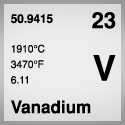
PURE VANADIUM EXHIBITS EXCELLENT CORROSION RESISTANCE IN MARINE ENVIRONMENTS.
Vanadium is a reactive metal; a sister element to niobium and tantalum. It has many attractive properties like low fusion neutron capture cross-section, low rate of neutron embrittlement, good corrosion resistance and a relatively low density. The inelastic-scattering cross-section is quite small, but the thermal neutron cross-section is large and its usefulness in thermal reactors is, therefore, limited. Vanadium is resistant to salt water, dilute hydrochloric acid and sodium hydroxide solutions. The resistance to molten lithium is excellent.
PROPERTIES
Vanadium is a gray-white ductile metal and is in group 5 of the periodic table along with niobium and tantalum.
- Atomic No. 23
- Atomic Wt. 50.9415
- Specific Gravity 6.11
- Coefficient of Thermal Expansion 8.4 X 10-6/°K
- Specific Heat 0.117 cal/g/°K
- Ultimate Tensile Strength (Room Temperature, Annealed) 116 ksi
- Yield Tensile Strength (Room Temperature, Annealed) 113 ksi
- Poisons Ratio 0.36
- Modulus of Elasticity 18.2 X 106 psi
- Thermal Neutron Capture cross-section 4.7+-0.02 X 10-25 m2/atom
- Capture cross-section for 1 MeV neutrons 3 X 10-31 m2/atom
GENERAL CORROSION RESISTANCE
Vanadium exhibits resistance to alkalis, sulfuric acid, hydrochloric acid and marine environments. The metal oxidizes rapidly at temperatures above 600˚C.
This data is based on laboratory testing only. Your in-plant results may differ. Testing is recommended under other conditions as needed
